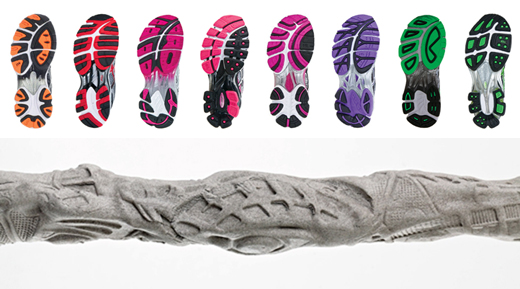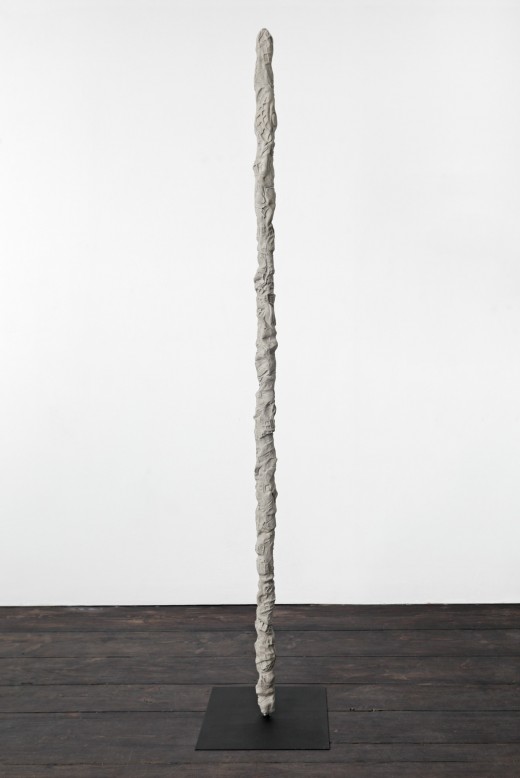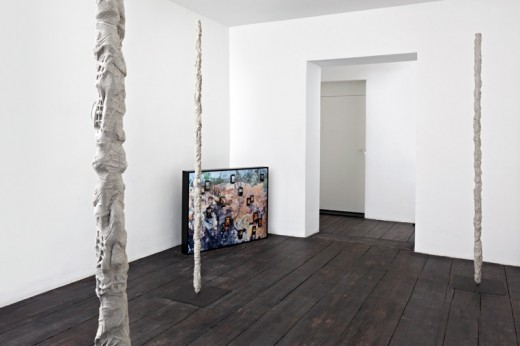Unique, Unique-er, Unique-est
Agatha Wara

Ergonomic fingerprints, from left to right: Asics Gel Nimbus; Asics Gel Kayano; Asics Gel GT 2160; Asics Gel Kinsei; Asics Gel Nimbus; Asics Gel GT 2170; Asics Gel Dame 3020; Asics Gel Kinetic. Courtesy of Agatha Wara. Anne de Vries, Detail of “Trance Tracks,” 2011. Sand and epoxy clay.
Yet, for De Landa, the simple question persists: “How do we come to terms with the virtual reality that our brains are producing right now?” De Landa’s account of reality comes from a theory of systems (in Deleuzian terms, “assemblages”). Everything in our world and of every scale, from the global economy down to a single bacterium, can be thought of as a system, one that is fundamentally made up of matter. The world is dynamic, and matter functions with its own capacities, potentialities, and tendencies. This breaks the classical distinction between substance and form that asserts that form is created by an external force (e.g., a human, God, or an artist) and gives shape to a certain substance, or material. Yet if matter is active, then its role in the shaping of its form must be recognized. And thus forms, or systems, through a materialist account, are seen as the outcomes of interactions between matter of heterogeneous capacities.
What this implies for the human body is that it too, as a system, is the outcome of interactions of material capacities, and is therefore ontologically equal to other bodies: humans, animals, societies, geological formations, etc. Thus, the “virtual reality” that we experience every day is the interaction of our bodies with the incredibly complex mesh of systems located in our environment.
The interest in speculative thinking and all things non-human in philosophy over past decades is more and more becoming reflected in technological innovation, consumer products, and global environmental policy. In 2011, the multinational computer manufacturer IBM forecasted the top five technologies that would reach the consumer market by 2016. Number one on the list was the ability to store and convert energy created when running, for instance, to power our electronic devices. In other words, humans are not special beings extricated from reality, but beings whose bodies run off of the same electricity that it takes to power their cellphones.
Similarly, “humanness” continues to come into question every time “human rights” are granted to non-human entities: the scientific campaign to grant dolphins rights as “non-human persons,” the granting of human rights to nature by the Bolivian government in 2011, American corporations gaining legal rights as “natural persons” under the Corporate Personhood law passed in 2010. Unquestionably, conceiving of the human being as a system that is bound to the processes of our environment has an effect on artistic thinking. Anne de Vries’s sculpture “Trance Tracks” (2011) reaches for a renewed relationship with the material world by pointing to a commonplace emergence in our commodity-driven landscape: the ergonomic product. Made from a mixture of epoxy clay and beach sand, the three columns that make up “Trance Tracks” have been roughly shaped using the soles of running shoes. De Vries writes, “The imprints forged by ergonomic footwear, designed to augment the body, remain as traces forming future terrains.” Trapped in these mutable surfaces are the traces left behind by an imaginary track meet that has taken place in another domain. We are prompted to question the manifestation of the ergonomic trace in daily life.

Anne de Vries, “Trance Tracks,” 2011. Sand and epoxy clay.
Today’s complex ergonomic field expands over varied disciplines, including biomechanics, industrial design, anthropometry, and psychology. The human body and its potentials have been measured and analyzed to determine the muscle force required to perform tasks like lifting, cardiovascular activity while performing heavy labor, and the maximum weight that can be safely carried, pushed, or pulled. And although the field has largely evolved from its beginnings, the principles of ergonomic design remain the same: to consider the “fit” between the user, and environment. Returning to ‘Trance Tracks’ we discover that de Vries has given us a clue. He states, “One reference [for “Trance Tracks”] might be Brancusi’s monumental “Endless Column (1938).” Built as a World War I memorial, the stack of rhomboids was created to symbolize ascension to heaven. Through similar gestures in form, we are presented with different notions of what enhanced realities could be.

Anne de Vries, “Trance Tracks,” 2011. Sand and epoxy clay.
Through the ergonomic holy trinity—fit, user, and environment—the athletic shoe is geared toward enhancing the body’s performance. Every manufacturer has its own system of delivery. Nike’s Shox soles, for instance, are said to “add more power to the stride, and boost speed.” While Reebok claims that their RealFlex zig-zag soles “cushion up and down like regular shoes, but also horizontally.” The zigs absorb impact while the zags “return energy.”
On the one hand, the language used to market the ergonomic product suggests that we enter an enhanced reality each time we put on our running shoes, insofar as they help us experience added speed, more power, and a return of energy. Yet this language also implies the already present materialist tendency to conceive of the human body as a material emergence, one that produces energy and one that can be optimized. This realization is sure to make critical theory cringe, since conceiving of the body as merely material fits so nicely into its critiques of power, mainly the neoliberal dictate that has required us to give 200 percent of mind, body, and soul, has achieved what it has wanted all along: to turn humans into mere tools.
But the question in front of us now is whether we can put aside these inherited discourses of power (if only for a moment) to think about what we can gain from a materialist account of the human being today. The allure of non-human philosophies, argues philosopher Graham Harman, comes from the larger political frameworks of this moment. The observation that things are becoming livelier and more “human” (dolphins, forests, corporations) alongside the increasing climate crises, is what underlies the interest in such theoretical frameworks. To put it more directly, we are witnessing the consequences, the pitfalls, of a total separation of ourselves from the material world around us.
Trapped in a basin of epoxy and sand, the ergonomic trace in “Trance Tracks” signifies the intrinsic connection that exists between the hard matter in our bodies and the hard matter in our environment. By creating forms of such minimal nature, de Vries wants to direct all of our attention to the uncanny beauty of the ergonomic mark, urging us not to extricate ourselves from the world, but to touch matter, to interact with the forces that we are intrinsically tied to. “Trance Tracks” thus creates a terrain in which the human does not stand as the unique-est being, in a manifestation that could not be more beautiful.










